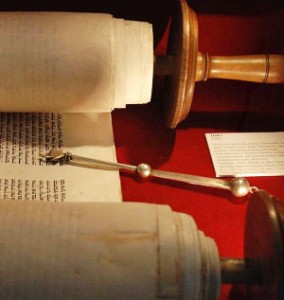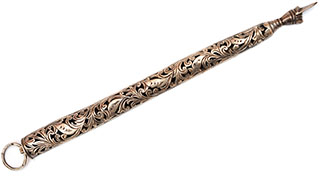 The pointer, or yad, was developed for utilitarian reasons to aid in reading the Torah. It is called a yad, which literally means ‘hand’, as traditionally the end of it is shaped like a hand with the fore-finger pointing forward. Previously, the reader would point with his index finger to the words he was reading but this made it difficult for the person called to the Torah to see the script and follow the reading. It also potentially damaged the Torah scroll as touching the scroll with a finger results in deposits of grease which build up over time and mark the scroll.
The pointer, or yad, was developed for utilitarian reasons to aid in reading the Torah. It is called a yad, which literally means ‘hand’, as traditionally the end of it is shaped like a hand with the fore-finger pointing forward. Previously, the reader would point with his index finger to the words he was reading but this made it difficult for the person called to the Torah to see the script and follow the reading. It also potentially damaged the Torah scroll as touching the scroll with a finger results in deposits of grease which build up over time and mark the scroll.
The yad probably originated in Germany in the 16th century, and then spread from Central Europe to Jewish communities everywhere.
By developing the yad, the end of which was in the form of a hand with its index finger extended, the problem was solved. It was designed as a yad (hand) rather than just a pointer to represent the hand of the reader.
When reading the Torah, every care must be taken not to touch the parchment. The reader indicates the text he is reading by means of the silver yad. The handles of the scroller must be grasped instead of the parchment when winding the Torah on.
The yad is one of the decorative accessories of the Sefer Torah, known as ritual articles or ‘tashmishay kedusha’. It has a degree of sanctity approaching that of the Torah scroll itself.



